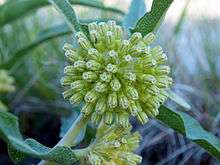Asclepias viridiflora
Asclepias viridiflora, common names green milkweed, green comet milkweed, and green-flower milkweed is a widely distributed species of milkweed known from much of the eastern and central United States from Connecticut to Georgia to Arizona to Montana, as well as southern Canada.
| Green milkweed | |
|---|---|
 | |
| Scientific classification | |
| Kingdom: | Plantae |
| Clade: | Tracheophytes |
| Clade: | Angiosperms |
| Clade: | Eudicots |
| Clade: | Asterids |
| Order: | Gentianales |
| Family: | Apocynaceae |
| Genus: | Asclepias |
| Species: | A. viridiflora |
| Binomial name | |
| Asclepias viridiflora | |
| Synonyms[1] | |
| |
Asclepias viridiflora is an erect to ascending herb up to 50 cm tall, with distinctive greenish-white flowers. The pods lack the warts and tubercules common on other species of Asclepias.[2][3][4]
Conservation status
It is listed as endangered in Florida, as threatened in New York (state), and as endangered in Connecticut.[5][6]
Native American Ethnobotany
The Blackfoot apply a poultice of chewed roots to swellings, to "diarrhea rash", to rashes, to the sore gums of nursing infants[7] and to sore eyes.[8] They also chew the root for sore throats,[9] and use the plant to spice soups, and use the fresh roots for food.[10] The Brulé Lakota give pulverized roots to children with diarrhea, and an infusion of the whole plant is taken by mothers to increase their milk.[11]
References
- "Asclepias viridiflora". World Checklist of Selected Plant Families (WCSP). Royal Botanic Gardens, Kew – via The Plant List.
- Sundell, E. 1993. Asclepiadaceae, Milkweed Family. Journal of the Arizona-Nevada Academy of Science 27:169-187.
- "Asclepias viridiflora". Native Plant Database. Lady Bird Johnson Wildflower Center, University of Texas at Austin.
- Rafinesque. C.S. Medical Repository, ser. 2, 5: 360. 1808.
- "Connecticut's Endangered, Threatened and Special Concern Species 2015". State of Connecticut Department of Energy and Environmental Protection Bureau of Natural Resources. Retrieved 31 December 2017.(Note: This list is newer than the one used by plants.usda.gov and is more up-to-date.)
- "Asclepias viridiflora". Natural Resources Conservation Service PLANTS Database. USDA. Retrieved 16 December 2017.
- Hellson, John C., 1974, Ethnobotany of the Blackfoot Indians, Ottawa. National Museums of Canada. Mercury Series, page 75
- Hellson, John C., 1974, Ethnobotany of the Blackfoot Indians, Ottawa. National Museums of Canada. Mercury Series, page 80
- Hellson, John C., 1974, Ethnobotany of the Blackfoot Indians, Ottawa. National Museums of Canada. Mercury Series, page 71
- Hellson, John C., 1974, Ethnobotany of the Blackfoot Indians, Ottawa. National Museums of Canada. Mercury Series, page 101
- Rogers, Dilwyn J, 1980, Lakota Names and Traditional Uses of Native Plants by Sicangu (Brule) People in the Rosebud Area, South Dakota, St. Francis, SD. Rosebud Educational Scoiety, page 34